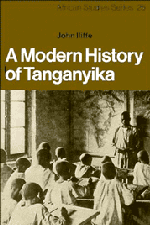Book contents
- Frontmatter
- Contents
- List of maps and tables
- Preface
- Acknowledgments
- Terminology
- Abbreviations
- Map I Tanganyika
- 1 Intentions
- 2 Tanganyika in 1800
- 3 The nineteenth century
- 4 The German conquest
- 5 Colonial economy and ecological crisis, 1890–1914
- 6 The Maji Maji rebellion, 1905–7
- 7 Religious and cultural change before 1914
- 8 Fortunes of war
- 9 The origins of rural capitalism
- 10 The creation of tribes
- 11 The crisis of colonial society, 1929–45
- 12 Townsmen and workers
- 13 The African Association, 1929–48
- 14 The new colonialism
- 15 The new politics, 1945–55
- 16 The nationalist victory, 1955–61
- Bibliography
- Index
6 - The Maji Maji rebellion, 1905–7
Published online by Cambridge University Press: 03 May 2011
- Frontmatter
- Contents
- List of maps and tables
- Preface
- Acknowledgments
- Terminology
- Abbreviations
- Map I Tanganyika
- 1 Intentions
- 2 Tanganyika in 1800
- 3 The nineteenth century
- 4 The German conquest
- 5 Colonial economy and ecological crisis, 1890–1914
- 6 The Maji Maji rebellion, 1905–7
- 7 Religious and cultural change before 1914
- 8 Fortunes of war
- 9 The origins of rural capitalism
- 10 The creation of tribes
- 11 The crisis of colonial society, 1929–45
- 12 Townsmen and workers
- 13 The African Association, 1929–48
- 14 The new colonialism
- 15 The new politics, 1945–55
- 16 The nationalist victory, 1955–61
- Bibliography
- Index
Summary
Outbreak
On a morning late in July 1905 the men of Nandete climbed a path towards a field of ripening cotton which they had cultivated. When they reached it their leaders, Ngulumbalyo Mandai and Lindimyo Machela, stepped forward and pulled three plants out of the ground. They did this in order to declare war on the German Empire.
The Maji Maji rebellion was an explosion of African hatred of European rule. It was a final attempt by Tanganyika's old societies to destroy the colonial order by force, and its failure made the passing of the old societies inevitable. It is therefore a last opportunity to study the workings of those societies amidst an incomparably vivid crisis for which there exists detailed evidence unmatched for earlier periods or other parts of Africa. The rebellion began among the stateless peoples of the south-east and extended to the newly created states of the Southern Highlands. It took place at the moment of transition from the nineteenth-century economy to the colonial order and it began as a movement of highlanders and frontiersmen resisting incorporation into the colonial economy and reduction to peasant status. To uproot cotton was therefore an apt ultimatum. To the men of Nandete, in the Matumbi highlands north-west of Kilwa, cotton symbolised the foreign penetration and control which had followed defeat in the ‘war of the pumpkins’ seven years earlier.
- Type
- Chapter
- Information
- A Modern History of Tanganyika , pp. 168 - 202Publisher: Cambridge University PressPrint publication year: 1979
- 3
- Cited by

